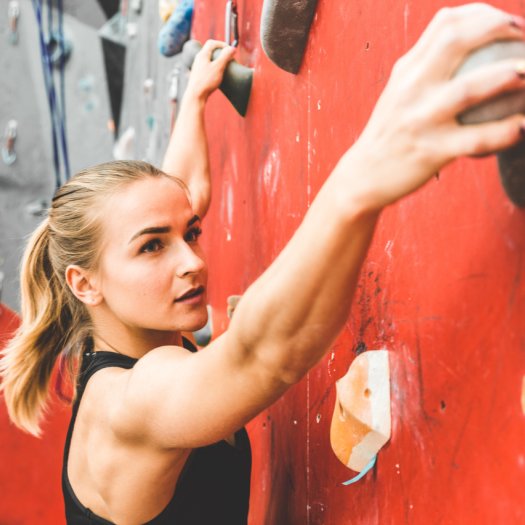Even if creativity and a sophisticated technique are in the foreground in bouldering: Without a good basic fitness and a good portion of strength nothing works. Whether upper body, trunk or legs - on the wall all muscles of the body are extremely challenged.
While our leg muscles are constantly in use due to the daily standing, walking or running, so they usually don't get tired so quickly, it's a different story for the upper body. Especially the back, shoulders, arms and fingers are not used to this kind of strain as in bouldering.
In order to have an extra portion of power and fitness for the next climbing session, here's an overview of five top fitness exercises for boulderers.
Hardly any other exercise is as effective for bouldering and climbing as the classic pull-up. Pull-ups train our upper body strength - especially back and biceps, but also shoulders and neck are challenged. Especially important: our hand and finger strength, which plays a very important role especially in bouldering, is also strengthened with pull-ups. In addition to increasing strength, pull-ups are also ideal for building body tension and developing a feeling for "hanging".
In order to train as realistically as possible, it is recommended to introduce a lot of variety into one's fitness workout and, for example, to vary the grip when doing pull-ups. For example, you can train with a pronated grip, i.e. palms facing outward, a supinated grip, i.e. palms facing inward, and a neutral parallel grip.
It is also advisable to change the grip width from time to time. Five sets of eight to ten repetitions each are already decent - newcomers can also try the latissimus pull first.
"Strength comes from the legs" is an old climbing adage. The best way to build up basic strength in the legs, buttocks and trunk is the squat. Again, a lot of body tension is required to keep the body upright and stabilized.
In bouldering, this benefits everyone, because the better the body tension is trained, the easier it is to maintain balance and position the body plumb line as close to the wall as possible. The following applies to the execution: form a slight hollow back, tense the entire torso and press out of the heels if possible.
As an alternative to squats, you can also do lunges, known as lunges. For additional coordination and balance training, you can perform the exercises on unstable surfaces such as balance boards. Five sets of six to eight repetitions each are sufficient here.
Tiny holds, narrow edges or brittle cracks in the natural rock - it's always your fingers that make direct contact between you and the wall. It's not uncommon to have to make the odd daring leap from one handhold to the next, or to dangle in the air for a while on just one hand. Strong and durable fingers are therefore a must.
The best training for hand and finger strength: bouldering. If you want to do something for your fingers outside the climbing wall, you should try using special hand clamps or simply a tennis ball. Hand and finger strength can also be trained with a theraband.
A particularly strenuous but for bouldering highly efficient exercise is "hanging". Simply cling to a bar or ledge and try to hold the long extended body as long as possible. In addition to pure strength, which we already train in the pull-up, the focus here is particularly on strength endurance.
A good guideline for beginners is around 30 seconds. If you can hold out for five repetitions, you're doing well. For variety and to increase the difficulty in advanced training, you can also hang on only one arm or use only two or three fingers.
In addition to fitness, strength and strength endurance, body tension and balance are important in bouldering. An excellent exercise here is the forearm support. Simply shift the weight to the forearms and toes, making sure that the center of the body does not sink and remains under tension. To increase the difficulty and add some dynamics, you can alternate between push-up position and forearm support while holding.
Again, do five 30-second rounds - increasing the time by a few seconds with each workout. If you can do five repetitions of one minute, you can also lift one leg at a time and extend it upward. Be careful not to fall into a hollow back during the changeover.
What are the top five rock climbing exercises for boulderers?
The top five fitness exercises for boulderers mentioned in the text are Pull-ups, Squats, Finger strength training, Hanging for strength endurance, and Forearm support.
How does the rock climbing exercise of pull-ups benefit boulderers?
Pull-ups are effective for bouldering and climbing as they train upper body strength, including the back, biceps, shoulders, and neck. They also strengthen hand and finger strength, which is crucial in bouldering.
What is the recommended guideline for beginners when performing strenuous hanging exercise for strength endurance?
For beginners, a good guideline for the strenuous hanging exercise is around 30 seconds. If you can hold out for five repetitions of 30 seconds each, you're doing well.
How can boulderers improve their balance and body tension with an exercise?
Boulderers can improve their balance and body tension through the forearm support exercise. By shifting weight to the forearms and toes while maintaining tension in the center of the body, they can enhance balance, body tension, and coordination.
What are some alternatives to squats for building leg strength in boulderers?
Lunges, known as lunges, can be alternatives to squats for building leg strength in boulderers. Additionally, exercises on unstable surfaces like balance boards can provide coordination and balance training.
 Know-HowThe 11 Best TRX Exercises
Know-HowThe 11 Best TRX Exercises
- ISPO awards
- Mountain sports
- Bike
- Design
- Retail
- Fitness
- Health
- ISPO Job Market
- ISPO Munich
- ISPO Shanghai
- Running
- Brands
- Sustainability
- Olympia
- OutDoor
- Promotion
- Sports Business
- ISPO Textrends
- Triathlon
- Water sports
- Winter sports
- eSports
- SportsTech
- OutDoor by ISPO
- Heroes
- Transformation
- Sport Fashion
- Urban Culture
- Challenges of a CEO
- Trade fairs
- Sports
- Find the Balance
- Product reviews
- Newsletter Exclusive Area
- Magazine



